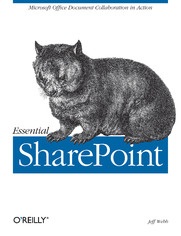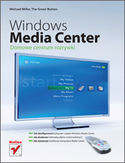Essential SharePoint. Microsoft Office Document Collaboration in Action - Helion

ISBN: 978-05-965-5316-6
stron: 336, Format: ebook
Data wydania: 2005-05-17
Ksi─Ögarnia: Helion
Cena ksi─ů┼╝ki: 101,15 z┼é (poprzednio: 117,62 z┼é)
Oszczędzasz: 14% (-16,47 zł)
Want to work more efficiently and effectively? Want to improve productivity? Microsoft is betting that you do. That's why it created Windows SharePoint Services--a set of collaboration tools that helps organizations increase individual and team productivity by enabling them to create web sites for information sharing and document collaboration.Through these team-oriented web sites, users capture and share ideas, and work together on documents, tasks, contacts, etc.--either among themselves or with partners and customers. And if you have Windows 2003 Server, then you already have SharePoint, since it's built right in. But before you can enjoy the benefits of SharePoint, you need to know how to turn it on, set it up, and get your applications working with it.Essential Sharepoint will help you do just that. It's not only the most complete guide for setting up and using these increasingly popular sites, but it also explains in detail the integration that makes SharePoint exciting. Everything you need to know about SharePoint is covered, including:
- hosting choices
- administration
- customization
- integration with Microsoft Office
- developing new SharePoint functionality
- when to use SharePoint portal server
Osoby które kupowały "Essential SharePoint. Microsoft Office Document Collaboration in Action", wybierały także:
- Microsoft SharePoint 2013 PL. Architektura i skuteczne rozwi─ůzania 79,00 z┼é, (47,40 z┼é -40%)
- SharePoint 2013 PL. Praktyczne zarz─ůdzanie zasobami informacyjnymi w przedsi─Öbiorstwie 59,00 z┼é, (35,40 z┼é -40%)
- Microsoft SharePoint 2010 PL. Praktyczne podej┼Ťcie 49,89 z┼é, (37,42 z┼é -25%)
- Microsoft SharePoint 2016 Krok po kroku 89,04 zł, (68,56 zł -23%)
- Microsoft SharePoint 2010 Poradnik Administratora - Tom 1 i 2 185,88 zł, (144,99 zł -22%)
Spis tre┼Ťci
Essential SharePoint. Microsoft Office Document Collaboration in Action eBook -- spis tre┼Ťci
- Essential SharePoint
- SPECIAL OFFER: Upgrade this ebook with OReilly
- Preface
- Who Should Read This Book
- Navigating in SharePoint
- Getting the Code Examples
- If You Need Help
- Font Conventions
- How to Contact Us
- Safari Enabled
- Acknowledgments
- 1. Why Use SharePoint?
- 1.1. Solving Problems
- 1.2. Storing and Sharing
- 1.3. Improving Collaboration
- 1.4. Going Public
- 1.5. Organizing Sites
- 1.6. Types of Sites
- 1.7. Parts of a Page
- 1.8. Where Are the Files?
- 1.9. Putting SharePoint to Work
- 1.10. Holding Meetings
- 1.11. Building Libraries
- 1.12. Creating Internet Sites
- 1.13. What Software Do You Need?
- 1.14. Trying Out SharePoint
- 1.15. Whats SharePoint Not Good For?
- 1.16. Resources
- 2. Getting Started
- 2.1. Before You Begin
- 2.2. Creating Hosted Sites
- 2.3. Adding Members
- 2.4. Changing Pages
- 2.5. Adding Content
- 2.5.1. Adding Lists
- 2.5.2. Building Libraries
- 2.5.3. Constructing New Pages
- 2.5.4. Creating Workspaces
- 2.5.5. Workspaces Versus Libraries
- 2.6. Setting Client Security
- 2.7. Creating Self-Hosted Sites
- 2.8. Installing SharePoint Services
- 2.8.1. Questions to Ask Before You Install
- 2.8.2. Checking SQL Server
- 2.8.3. Preparing Your Host Server
- 2.8.3.1. Integrating existing sites
- 2.8.3.2. Upgrading from SharePoint Team Services
- 2.8.3.3. Coexisting with Exchange Server
- 2.8.4. Installing SharePoint
- 2.8.5. Upgrading WMSDE to SQL Server
- 2.8.6. Setting Up a Web Farm
- 2.8.7. Creating Virtual Servers
- 2.8.7.1. Creating a top-level site in IIS
- 2.8.7.2. Extending the site with SharePoint
- 2.8.8. Re-Enabling Existing Sites
- 2.9. Adding Members Quickly
- 2.10. Allowing Anonymous Access
- 2.11. Maintaining Server Security
- 2.12. Enabling Self-Service Site Creation
- 2.13. Resources
- 3. Applying Templates, Themes, and Styles
- 3.1. Understanding Templates
- 3.2. Creating Custom Site Templates
- 3.2.1. Viewing, Editing, and Deleting Template Files
- 3.2.2. Replacing a Predefined Template
- 3.2.3. Adding Pages
- 3.2.4. Changing the Built-in Pages
- 3.3. Creating Site Definitions
- 3.3.1. Customizing Site Definitions
- 3.3.2. Adding and Changing Pages in Site Definitions
- 3.3.3. Debugging Site Definitions
- 3.4. Distributing Site Templates
- 3.5. Creating List Templates
- 3.6. Adding List Views
- 3.6.1. Sorting, Filtering, and Highlighting with Views
- 3.6.2. Displaying Views in Web Parts
- 3.6.3. Adding Views to List Templates
- 3.7. Creating List Definitions
- 3.8. Modifying Themes
- 3.9. Applying Style Sheets
- 3.10. Changing the Default Icons
- 3.10.1. Resources
- 4. Sharing Contacts and Meetings with Outlook
- 4.1. Sharing Contacts
- 4.1.1. Creating Contacts Lists
- 4.1.2. Copying Contacts from Outlook to SharePoint
- 4.1.3. Editing Shared Contacts Quickly
- 4.1.4. Linking SharePoint Contacts to Outlook
- 4.1.5. Editing Shared Contacts from Outlook
- 4.2. Organizing Meetings
- 4.2.1. Creating a Meeting Workspace
- 4.2.2. Creating Different Types of Workspaces
- 4.2.3. Linking to an Existing Workspace
- 4.3. Resources
- 4.1. Sharing Contacts
- 5. Sharing Workspaces and Lists with Excel
- 5.1. Getting Started with Excel and SharePoint
- 5.2. Sharing Workbooks
- 5.2.1. Using the Task Pane
- 5.2.2. Adding Documents
- 5.2.3. Adding Members
- 5.2.4. Sending and Receiving Alerts
- 5.2.5. Assigning Tasks
- 5.2.6. Controlling Updates
- 5.2.7. Opening a Shared Workbook
- 5.2.8. Checking Files In and Out
- 5.2.9. Reconciling Changes and Viewing History
- 5.3. Sharing Lists
- 5.3.1. Viewing SharePoint Lists in Excel
- 5.3.2. Importing Lists into Existing Workbooks
- 5.3.3. Editing Lists and Reconciling Changes
- 5.3.4. Creating and Sharing Lists in Excel
- 5.4. Publishing as a Web Page
- 5.5. Using the Spreadsheet Web Part
- 5.6. Programming SharePoint in VBA
- 5.6.1. Creating Workspaces
- 5.6.2. Opening Workbooks from a Shared Workspace
- 5.6.3. Removing Sharing
- 5.6.4. Responding to Updates
- 5.6.5. Creating a List
- 5.6.6. Sharing a List
- 5.6.7. Inserting a Shared List
- 5.6.8. Refreshing and Updating
- 5.6.9. Unlinking, Unlisting, and Deleting
- 5.6.10. Resources
- 6. Using Document Libraries with Word
- 6.1. Understanding Libraries
- 6.2. Adding Documents to a Library
- 6.3. Creating New Documents
- 6.3.1. Starting from Word
- 6.3.2. Starting from the Library
- 6.4. Adding Document Properties
- 6.5. Changing the Library Template
- 6.6. Linking Documents to Libraries
- 6.7. Making Revisions Privately
- 6.8. Linking and Publishing Custom Properties
- 6.9. Discussing a Document
- 6.10. Enabling Emailed Submissions
- 6.11. Approving/Rejecting Documents
- 6.12. Responding to Events
- 6.13. Searching for Documents
- 6.14. Resources
- 7. Gathering Data
- 7.1. Using Lists to Gather Data
- 7.1.1. Building a Lookup Table
- 7.1.2. Creating a Data List
- 7.1.3. Adding Totals, Groupings, and Filters
- 7.1.4. Modifying the New Item Form
- 7.1.4.1. Creating a new default view
- 7.1.4.2. Add the list form web part list form web part
- 7.1.4.3. Editing the new view
- 7.1.5. Changing Pages to View/Edit/Add Items
- 7.1.6. Saving the List as a Template
- 7.2. Using Form Libraries to Gather Data
- 7.2.1. Understanding Form Libraries
- 7.2.2. Designing a Form
- 7.2.3. Creating a Form Library
- 7.2.4. Emailing Form Data
- 7.2.5. Customizing Forms
- 7.2.5.1. Adding controls
- 7.2.5.2. Setting conditional formatting
- 7.2.5.3. Writing code
- 7.2.5.4. Testing a form
- 7.2.5.5. Hiding controls
- 7.2.6. Populate a Control from a List
- 7.2.6.1. Creating a data connection
- 7.2.6.2. Adding bound controls
- 7.2.6.3. Filtering data
- 7.2.7. Validating Data
- 7.2.8. Preventing Changes to Form Templates
- 7.2.9. Generating HTML for Forms
- 7.2.10. Programming in .NET
- 7.2.10.1. Creating a project
- 7.2.10.2. Responding to events
- 7.2.10.3. Converting scripts to .NET
- 7.2.10.4. Debugging and deploying
- 7.2.11. Resources
- 7.1. Using Lists to Gather Data
- 8. Creating Web Parts
- 8.1. Preparing to Develop
- 8.1.1. Using Remote Desktop
- 8.1.2. Using Virtual PC
- 8.1.3. Configuring the Server for Development
- 8.2. Creating a Web Part Project
- 8.2.1. Creating a Test Page
- 8.2.2. Configuring a New Project
- 8.2.3. Building and Signing the Assembly
- 8.2.4. Registering the Web Part
- 8.2.5. Adding the Web Part to a Page
- 8.2.6. Troubleshooting
- 8.3. Deploying Web Parts
- 8.3.1. Deploying to the Virtual Server Gallery
- 8.3.2. Adding to the Site Gallery
- 8.3.3. Deploying as Windows Installer Files
- 8.3.4. Deploying to the Online Gallery
- 8.4. Creating Web Parts from Excel
- 8.5. Resources
- 8.1. Preparing to Develop
- 9. Programming Web Parts
- 9.1. Understanding Web Parts
- 9.1.1. Extending ASP.NET
- 9.1.2. Using Web Parts
- 9.1.3. Programming Tasks
- 9.2. Creating Web Part Appearance
- 9.3. Adding Child Controls
- 9.4. Working on the Client Side
- 9.4.1. Using Scripts with Web Controls
- 9.4.2. Importing Script Blocks
- 9.5. Understanding Event Order
- 9.6. Adding Properties
- 9.6.1. Setting Property Attributes
- 9.6.2. Serializing Properties
- 9.6.3. Linking Properties to Controls
- 9.6.4. Saving Property Settings
- 9.6.5. Controlling/Debugging Serialization
- 9.6.6. Setting Properties in DWP
- 9.7. Adding Menus
- 9.8. Customizing the Property Task Pane
- 9.9. Connecting Parts
- 9.9.1. Creating a Simple Connection
- 9.10. Resources
- 9.1. Understanding Web Parts
- 10. Remote Programming
- 10.1. Choosing an Approach
- 10.2. Using the Office Object Model
- 10.2.1. From VBA
- 10.2.2. From .NET
- 10.3. Using Web Services
- 10.3.1. From VBA
- 10.3.2. VBA Programming Tips
- 10.3.3. Working with Lists
- 10.3.3.1. Adding attachments
- 10.3.3.2. Retrieving attachments
- 10.3.3.3. Deleting attachments
- 10.3.3.4. Performing queries
- 10.3.4. From .NET
- 10.3.5. .NET Programming Tips
- 10.3.6. From ASP.NET
- 10.3.7. Using the Admin Service
- 10.4. Using URL Commands
- 10.4.1. Getting GUIDs
- 10.4.1.1. Using SharePoint objects
- 10.4.1.2. Using web services (.NET)
- 10.4.1.3. Using web services (VBA)
- 10.4.2. Executing URL Commands
- 10.4.1. Getting GUIDs
- 10.5. Using FrontPage RPC
- 10.5.1. Preparing a Page for RPC
- 10.5.2. Common RPC Tasks
- 10.5.2.1. Identifying lists
- 10.5.2.2. Combining multiple methods
- 10.5.2.3. Querying lists
- 10.5.2.4. Creating lists
- 10.5.2.5. Creating pages
- 10.5.2.6. Deleting items
- 10.5.2.7. Deleting lists
- 10.5.3. Resources
- A. Upgrading
- Upgrading to SQL 2000
- Upgrading to Portal Server
- Recording Settings
- Installing and Configuring Portal Server
- Re-Extending Existing Sites
- Connecting Sites to the Portal
- Adding Links to the Portal
- Upgrading from Team Services
- Resources
- B. Reference Tables
- Office Versions
- StsAdm Commands
- SetupSts Commands
- Server Files and Locations
- Content Not Stored in Database
- Index
- About the Author
- Colophon
- SPECIAL OFFER: Upgrade this ebook with OReilly





